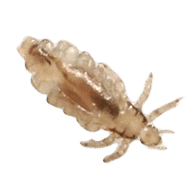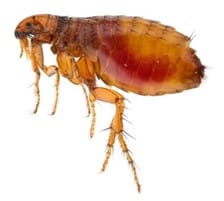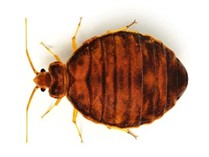Lice vs. Fleas & Other Pests
Unfortunately, there are a great many pests that plague both humans and pets, but it’s the world we live in! Often times, folks tend to confuse these pests, often leading to a misunderstanding of how to eradicate the problem. Below, we’ve gathered information on the most commonly talked about pests. Although they have several similarities, each of these insects have qualities that make them uniquely different.
Head Lice

- Head lice are tiny (1.5 to 3.55 mm), wingless insects approximately the size of a sesame seed
- Clear to light brown or red in color, darkening after feedings
- Built for crawling
- Can affect anyone, anywhere, of any socioeconomic background.
- Feed on blood of their host
- Lice are host-specific, meaning human lice prefer to snack on humans, while lice that affect pets prefer to snack on pets such as dogs and cats.
- Active: at all times of day or night
- Lifecycle: nit (head lice egg), nymph (not sexually mature adult), adult.
- Lifespan: 30 days
- Female can lay up to 100 eggs in her lifetime
- Life goal: find blood and reproduce
- Interesting fact: it has been documented that head lice have been plaguing humans since at least the 14th century!
Head lice infestation is a common problem affecting nearly 12 million children throughout the U.S., annually. There are many OTC treatments available including both pesticide-based solutions and non-toxic options.
Resources:
Fleas

- Small, wingless insects approximately 1.5 to 3.55 mm in size
- Dark in color, typically reddish-brown
- Built to jump with “cricket-like” hind legs (can jump vertically 7 inches!)
- Prefer to snack on dogs, cats, chickens, rabbits, mice, rats, ferrets, and sometimes humans
- Active: at all times
- Lifecycle: egg, larvae, pupae, adult.
- Feed on blood of their host
- Lifespan: up to 1.5 years
- Female can lay 5,000 or more eggs in her lifetime
- Life goal: find blood and reproduce
- Interesting fact: fleas do not have a mandible (i.e. jaw)! They actually suck their host’s blood using their epipharynx (the opening to the nasal cavity, above the soft palate).
For humans, there are many topical anti-itch treatments available for flea bites. For pets, topical treatments to kill fleas are available through a veterinarian or a pet supply store. If your home becomes infested, a local home and garden center can recommend an appropriate product and plan of action.
Bed Bugs

- Bed bugs are small insects (4-5 mm) with one set of wings located at the front of their bodies that resemble pad-like structures.
- Typically light to reddish brown, flat with an oval shape
- Often mistaken as small beetles
- Feed on blood of their host
- Snack on humans when other prey are unavailable
- Active: mostly at night
- Lifecycle: bed bugs have 5 immature nymph stages before becoming sexually mature adults
- Lifespan: dependent upon environment and on feeding, but on average, 6-12 months
- Life goal: find blood and reproduce
- Interesting fact: bed bugs release a foul-smelling pheromone when threatened (similar to “stink bugs”).
For treatment of bed bug bites, the topical anti-itch products recommended for flea bites (above) are also appropriate. As for eradication from the home, vacuuming furniture, mattresses and carpeting, in addition to washing bedding, linens, and towels in hot water (or, drying on high-heat) is the standard recommendation.
